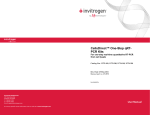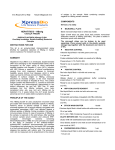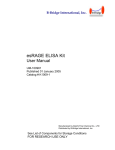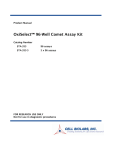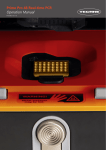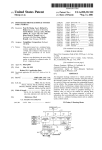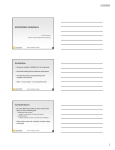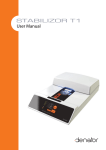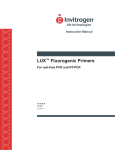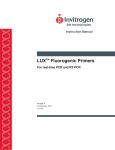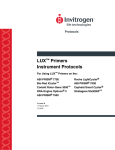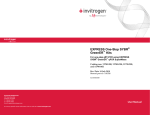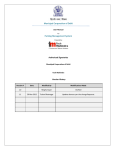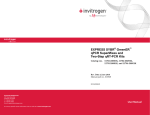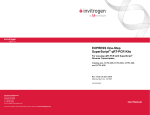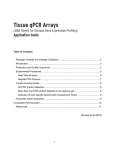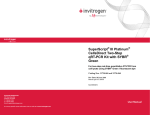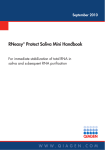Download RNA UltraSense™ One-Step Quantitative RT
Transcript
Page 4 Troubleshooting Guide Problem Possible Cause Probable Solution No amplification product Relative fluorescent signal ≤ background or no template control cDNA synthesis temperature too high, low priming efficiency RT or cDNA primer blocked by secondary structure RNA has been damaged or degraded RNase contamination Fluorescent probe not functional Lower incubation temperature. RNA UltraSense™ One-Step Quantitative RT-PCR System Raise incubation temperature. Redesign primer(s). Cat. No.: 11732-927 Replace RNA if necessary. Maintain aseptic conditions; add RNase inhibitor. Validate probe design and presence of fluorophore and quencher: Treat TaqMan® probe with DNase, and check for increase in fluorescence. Redesign and/or resynthesize probe if necessary. Poor sensitivity Not enough starting template RNA Increase the concentration of template RNA; use 10 ng to 1 µg of total RNA. Product detected at higher than expected cycle number RNA has been damaged or degraded RNase contamination RT inhibitors are present in RNA Replace RNA if necessary. Maintain aseptic conditions; add RNase inhibitor. Remove inhibitors in the RNA preparation by an additional 70% ethanol wash. Inhibitors of RT include SDS, EDTA, guanidium salts, formamide, sodium phosphate and spermidine (19, 20). Adjust cDNA synthesis temperature and/or primer design. Optimize PCR conditions: Adjust annealing temperature as necessary. Increase magnesium concentration. Redesign primers. Inefficient cDNA synthesis Inefficient PCR amplification Higher than expected signal Too much sample added to reactions Decrease the concentration of template RNA. Product detected at lowerthan-expected cycle number, and/or positive signal from no-template controls Template or PCR carry-over contamination Isolate source of contamination and replace reagent(s). Use separate dedicated pipettors for reaction assembly and post-PCR analysis. Assemble reactions (except for target addition) in a DNA-free area. Use aerosol-resistant pipet tips or positive displacement pipettors. Unexpected bands after electrophoresis RNA contamination with genomic DNA Oligo(dT) or random primers used for first-strand synthesis Low specificity in PCR Pre-treat RNA with DNase I. Use gene-specific primers. Optimize PCR conditions as described above. References 1. 2. 3. 4. 5. 6. Kotewicz, M.L., D'Alessio, J.M., Driftmier, K.M., Blodgett, K.P., and Gerard, G.F. (1985) Gene 35, 249. Gerard, G.F., D'Alessio, J.M., Kotewicz, M.L., and Noon, M.C. (1986) DNA 5, 271. Chou, Q., Russel, M., Birch, D., Raymond, J., and Bloch, W. (1992) Nucl. Acids Res. 20, 1717. Sharkey, D.J., Scalice, E.R., Christy, K.G., Atwood, S.M., and Daiss, J.L. (1994) BioTechnology 12, 506. Westfall, B., Sitaraman, K., Hughes, J., and Rashtchian, A. (1997) Focus® 19, 46. Lowe, B., Avila, H. A., Bloom, F., Gleeson, M., and Kusser, W. (2003) Anal. Biochem. 315, 95. 7. Nazarenko I., Lowe, B., Darfler, M., Ikonomi, P., Schuster, D., and Rashtchian, A. (2002) Nucleic Acids Res. 30, e37. 8. 9. 10. 11 12. 13. 14. 15. 16. 17. 18. 19. 20. Tyagi, S. and Kramer, F.R. (1996) Nature Biotechnology 14, 303. Tyagi, S., Bratu, D.P., and Kramer, F.R. (1998) Nature Biotechnology 16, 49. Kostrikis, L.G., Tyagi, S., Mhlanga, M.M., Ho, D.D., and Kramer, F.R. (1998) Science 279, 1228. Holland, P.M., Abramson, R.D., Watson, R., and Gelfand, D. H. (1991) Proc. Natl. Acad. Sci. USA 88, 7276. Gibson, U. E. M., Heid, C. A., and Williams, P.M. (1996) Genome Res. 6, 995. Heid, C. A., Stevens, J., Livak, K. J., and Williams, P. M. (1996) Genome Res. 6, 986. Nazarenko, I.A., Bhatnagar, S.K., and Hohman, R.J. (1997) Nucl. Acids Res. 25, 2516. Wittwer, C.T., Herrmann, M.G., Moss, A.A., and Rasmussen, R.P. (1997) Biotechniques 22,130. Ishiguro, T., Saitoh, J., Yawata, H., Yamagishi, H., Iwasaki, S., and Mitoma, Y. (1995) Anal. Biochem. 229, 207. Chomczynski, P. and Sacchi, N. (1987) Anal. Biochem. 162, 156. Chirgwin, J.M., Przybyla, A.E., MacDonald, R.J., and Rutter, W.J. (1979) Biochemistry 18, 5294. Berger, S.L. and Kimmel, A.R. (1987) Methods in Enzymol. 152, 316. Gerard, G. F. (1994) Focus® 16, 102. Limited Use Label License No. 1: Thermostable Polymerases A license under U.S. Patents 4,683,202, 4,683,195, 4,965,188, and 5,075,216 or their foreign counterparts, owned by Roche Molecular Systems, Inc. and F. Hoffmann-La Roche, Ltd. (“Roche”), has an up-front fee component and a running-royalty component. The purchase price of this product includes limited, nontransferable rights under the running-royalty component to use only this amount of the product to practice the polymerase chain reaction (PCR) and related processes described in said patents solely for the research and development activities of the purchaser when this product is used in conjunction with a thermal cycler whose use is covered by the up-front fee component. Rights to the up-front fee component must be obtained by the end user in order to have a complete license. These rights under the up-front fee component may be purchased from Applied Biosystems or obtained by purchasing an Authorized Thermal Cycler. No right to perform or offer commercial services of any kind using PCR including, without limitation, reporting the results of the purchaser’s activities for a fee or other commercial consideration, is hereby granted by implication or estoppel. Further information on purchasing licenses to practice the PCR process may be obtained by contacting the Director of Licensing at Applied Biosystems, 850 Lincoln Centre Drive, Foster City, California 94404 or at Roche Molecular Systems, Inc., 1145 Atlantic Avenue, Alameda, California 94501. ® Limited Use Label License No. 14: Platinum products Store at -20°C Description The RNA UltraSense™ One-Step Quantitative RT-PCR System is a one-step quantitative RT-PCR system for the sensitive, reproducible detection of low-abundance RNA molecules using real-time detection instruments. This system combines the high-temperature reverse transcription capability of SuperScript™ III Reverse Transcriptase (RT) with the automatic hot-start PCR provided by Platinum® Taq DNA Polymerase in a highly concentrated formulation that is optimized for the detection of viral RNA and rare transcripts. Both cDNA synthesis and PCR are performed in a single tube using gene-specific primers and RNA. All components necessary for real-time RT-PCR are mixed in the tube, and reverse transcription is directly followed by PCR cycling without additional handling, enabling sensitive detection from as few as 10 copies of highly dilute RNA template. The system consists of two major components: RNA UltraSense™ Enzyme Mix and RNA UltraSense™ 5X Reaction Mix. RNA UltraSense™ Enzyme Mix contains SuperScript™ III RT, Platinum® Taq DNA Polymerase, and RNaseOUT™ Ribonuclease Inhibitor. SuperScript™ III RT is a version of M-MLV RT that has been engineered to reduce RNase H activity and provide increased thermal stability (1, 2). The enzyme can be used to synthesize cDNA at a temperature range of 45–60°C, providing increased specificity, higher yields of cDNA, and more full-length product than other reverse transcriptases. SuperScript™ III RT is not significantly inhibited by ribosomal and transfer RNA, and can be used to synthesize cDNA from total RNA. Platinum® Taq DNA polymerase is recombinant Taq DNA polymerase complexed with a proprietary antibody that blocks polymerase activity at ambient temperatures (3, 4, 5). Activity is restored after the denaturation step in PCR cycling at 94°C, providing an automatic “hot start” in PCR for increased sensitivity, specificity, and yield. The RNA UltraSense™ 5X Reaction Mix consists of a proprietary buffer system, MgSO4, dNTPs, and stabilizers. The 5X concentrated format allows you to add your low-abundance template in high volumes, and MgSO4 is included in the mix at a final concentration that facilitates primer binding with difficult templates such as viral RNA. A tube of 50-mM MgSO4 is included in the kit for further optimization of the Mg2+ concentration. A tube of 20X Bovine Serum Albumin (BSA) is included for compatibility with the Roche LightCycler®. The RNA UltraSense™ One-Step Quantitative RT-PCR System has been formulated to provide optimal performance with Invitrogen’s fluorogenic LUX™ Primers, and also supports fluorogenic hybridization probe-based detection methods such as TaqMan® probes (6–16). We do not recommend using this kit with dsDNA binding dyes such as SYBR® Green I. Sufficient reagents are provided for 100 amplification reactions of 50 µl each. Note: This kit has been optimized for the rapid, convenient detection of low-abundance transcripts and viral RNA. For standard one-step quantitative RT-PCR, use the SuperScript™ III Platinum® One-Step Quantitative RT-PCR System (see Additional Products, below). System Component RNA UltraSense™ Enzyme Mix (includes RNaseOUT™ Ribonuclease Inhibitor) RNA UltraSense™ 5X Reaction Mix (contains 1 mM of each dNTP) 20X Bovine Serum Albumin (BSA), UltraPure, non-acetylated (1 mg/ml) 50-mM Magnesium Sulfate (MgSO4) ROX Reference Dye ™ The purchase of this product conveys to the buyer the non-transferable right to use the purchased amount of the product and components of the product in research conducted by the buyer (whether the buyer is an academic or for-profit entity). The buyer cannot sell or otherwise transfer (a) this product (b) its components or (c) materials made using this product or its components to a third party or otherwise use this product or its components or materials made using this product or its components for Commercial Purposes. The buyer may transfer information or materials made through the use of this product to a scientific collaborator, provided that such transfer is not for any Commercial Purpose, and that such collaborator agrees in writing (a) not to transfer such materials to any third party, and (b) to use such transferred materials and/or information solely for research and not for Commercial Purposes. Commercial Purposes means any activity by a party for consideration and may include, but is not limited to: (1) use of the product or its components in manufacturing; (2) use of the product or its components to provide a service, information, or data; (3) use of the product or its components for therapeutic, diagnostic or prophylactic purposes; or (4) resale of the product or its components, whether or not such product or its components are resold for use in research. Invitrogen Corporation will not assert a claim against the buyer of infringement of patents owned by Invitrogen Corporation and claiming this product based upon the manufacture, use or sale of a therapeutic, clinical diagnostic, vaccine or prophylactic product developed in research by the buyer in which this product or its components was employed, provided that neither this product nor any of its components was used in the manufacture of such product. If the purchaser is not willing to accept the limitations of this limited use statement, Invitrogen is willing to accept return of the product with a full refund. For information on purchasing a license to this product for purposes other than research, contact Licensing Department, Invitrogen Corporation, 1600 Faraday Avenue, Carlsbad, California 92008. Phone (760) 603-7200. Fax (760) 6026500. ©2004 Invitrogen Corporation. All rights reserved. For research use only. Not intended for any animal or human therapeutic or diagnostic use. Amount 250 µl 1 ml 300 µl 1 ml 100 µl Storage Store components at -20ºC. Stability can be extended by storing at -80ºC. ROX Reference Dye must be stored in the dark. Quality Control The product is tested functionally by quantitative real-time analysis using total HeLa RNA as template. Kinetic analysis must demonstrate a linear dose response with decreasing target concentration and detection of β-actin mRNA in 1 pg of total HeLa RNA. Additional Products The following products are also available from Invitrogen. Product Amount SuperScript™ III Platinum® One-Step Quantitative RT-PCR System 100 rxns 11732-020 500 rxns 11732-088 100 PCRs 11734-050 500 PCRs 11734-068 50 rxns 12183-018 100 ml 15596-026 200 ml 15596-018 100 units 18068-015 to order, visit www.invitrogen.com Licensed to Invitrogen Corporation, under U.S. Patent Nos. 5,338,671; 5,587,287, and foreign equivalents for use in research only. Limited Use Label License No. 138: SuperScript III Reverse Transcriptase Size: 100 reactions SuperScript™ III Platinum® Two-Step qRT-PCR Kit Micro-to-Midi Total RNA Purification System TRIzol® Reagent DNase I, Amplification Grade Custom Primers Part no. 11732927.pps Catalog no. Rev. date: 01 June 2010 Page 2 Recommendations and Guidelines for Quantitative Real-Time RT-PCR RNA RNA should be devoid of any RNase contamination and aseptic conditions should be maintained. RNaseOUT™ is included in the enzyme mix to safeguard against degradation of target RNA due to ribonuclease contamination of the RNA preparation. To isolate total RNA or viral RNA, we recommend TRIzol® Reagent (Cat. Nos. 15596-026/-018). To isolate total RNA, you can also use the Micro-to-Midi Total RNA Purification System (Cat. no. 12183018). Oligo(dT)-selection for poly(A)+ RNA is typically not necessary, although incorporating this step may improve the yield of specific cDNAs. Magnesium The RNA UltraSense™ 5X Reaction Mix includes MgSO4 at a concentration that facilitates primer binding with difficult templates such as viral RNA. If necessary, use the 50-mM magnesium sulfate solution included in the kit to increase the magnesium concentration. Instrument Settings This kit can be used with a variety of real-time instruments, including but not limited to the ABI PRISM® 7700/7000/7900 and GeneAmp® 5700, the Bio-Rad iCycler™, the Stratagene Mx4000™, Corbett Research’s Rotor-Gene™, MJ Research’s DNA Engine Opticon™, the Cepheid Smart Cycler®, and the Roche LightCycler®. Please refer to your instrument user manual for operating instructions. Optimal cycling conditions will vary with different machines. The protocols on the following page have been optimized for the ABI PRISM® 7700 and the Roche LightCycler®. ROX Reference Dye ROX Reference Dye included in each kit to normalize the fluorescent reporter signal in real-time RT-PCR. Its use is optional. ROX Reference Dye can be used to adjust for non-PCR-related fluctuations in fluorescence between reactions, and provides a stable baseline in multiplex reactions. It is composed of a glycine conjugate of 5-carboxy-X-rhodamine, succinimidyl ester (25 µM) in 20 mM Tris-HCl (pH 8.4), 0.1 mM EDTA, and 0.01% Tween® 20. ROX is supplied at 50X concentration. Add 1 µl of ROX for every 50 µl of reaction volume. ® Note that some TaqMan probes utilize a TAMRA quencher, which can be used as a reference dye for normalization of data. This technique is only valid for a reaction containing a single TaqMan® probe, and should not be used in multiplex applications. Bovine Serum Albumin (BSA) Additional bovine serum albumin (BSA) is required in Roche LightCycler® reactions because the glass capillaries in the LightCycler® have a high surface-to-volume ratio and the glass surface binds molecules like Taq DNA polymerase. The addition of BSA blocks this surface binding. Nonacetylated BSA is provided in the kit because acetylated BSA will inhibit PCR at the concentrations required in LightCycler® reactions. This inhibition is most likely due to the transfer of acetyl groups to essential components of the PCR, like the Taq DNA polymerase. Primers • Gene-specific primers (GSP) are required. We do not recommend using oligo(dT) or random primers, which may generate nonspecific products in the one-step procedure and reduce the amount of product. • Quantitative Real-Time One-Step RT-PCR Protocol Separate cycling programs and reaction mixtures are provided for instruments that use PCR tubes/plates (e.g., ABI PRISM®, Bio-Rad iCycler™, Stratagene Mx4000™, Cepheid Smart Cycler®) and the Roche LightCycler®. A standard 50-µl reaction size is provided for instruments that use PCR tubes/plates; component volumes can be scaled as desired. 1. Program the real-time instrument to perform cDNA synthesis immediately followed by PCR amplification as shown below. Optimal temperatures and incubation times may vary for different target sequences (see Reaction Setup and Conditions, previous page). For mRNA, design primers that anneal to exons on both sides of an intron or within the exon/exon boundary to allow differentiation between amplification of cDNA and potential contaminating genomic DNA. • Primers should be designed according to standard PCR guidelines. They should be specific for the target sequences, be free of internal secondary structure, and should avoid complementation at 3′ end within each primer, primer pair, or hybridization probe sequence (except as required for hairpin fluorogenic primers such as LUX™). For best results, the amplicon size should be limited to 80–200 bp. • Optimal results may require a primer titration between 100 and 500 nM. A final concentration of 200 nM per primer is effective for most reactions. • For multiplex applications, limit the amount of primer for the reference gene, such as β-actin or GAPDH, to avoid competition between amplification of the reference gene and sample gene. In general, the final concentration of the reference gene primer should be between 25 and 100 nM. However, a primer titration is recommended for optimal results. Instruments using PCR tubes/plates 50°C for 15 min hold* 95°C for 2 min hold 40–50 cycles of: 95°C, 15 s 60°C, 30 s Melting Curve Analysis: Refer to instrument documentation • • 2. The probe sequence should be free of secondary structure and should not hybridize to itself or to primer 3′ ends. Reaction Component ™ RNA UltraSense Enzyme Mix For multiplex applications, the concentration of each probe may need to be adjusted independently to obtain optimal fluorescent signals. The amount of probe for the reference gene, such as βactin or GAPDH, should be limited as described above for primers. SuperScript™ III RT is inactivated, the RNA/cDNA hybrid is denatured, and Platinum® Taq DNA polymerase is activated during the 2-min incubation at 95°C. • The annealing temperature should be 0–10°C below the melting temperature of the primers used. • The extension time of 30 seconds for instruments that use PCR tubes/plates is appropriate for the short amplicons that are typically used in real-time PCR. 1 RNA UltraSense™ 5X Reaction Mix Instruments using PCR tubes/plates: LightCycler®: 1 rxn/100 rxns 1 rxn/34 rxns 2.5 µl/250 µl 1 µl/34 µl 10 µl/1000 µl 4 µl/136 µl 20X Bovine Serum Albumin2 LUX™ Primers3 Labeled primer, 10 µM Unlabeled primer, 10 µM — 1 µl/34 µl 1 µl/100 µl 1 µl/100 µl 1 µl/34 µl 1 µl/34 µl or TaqMan® Probes Primer pair, 10 µM each Fluorogenic probe, 10 µM 1 µl/100 µl 1 µl/100 µl 1 µl/34 µl 1 µl/34 µl ROX Reference Dye (optional) Efficient cDNA synthesis can be accomplished in a 15–30 min incubation at 45–60°C. Optimal temperature varies for different primers and templates. A good general starting point is 50°C for 15 min. For problematic templates, or to increase the specificity of cDNA priming, increase the cDNA synthesis temperature to 55°C. • Melting Curve Analysis: Program choice: Melting curve Analysis mode: Melting curves 95oC, 0 s 55oC, 15 s 95oC, 0 s 40oC, 0 s Prepare a master mix on ice of all components except template, as specified below. Note: Preparation of a master mix is crucial in quantitative applications to reduce pipetting errors. Reaction Setup and Conditions • Keep all components, reaction mixes and samples on ice. After reaction assembly, transfer them to a thermal cycler pre-heated to the desired cDNA synthesis temperature (45–60°C) and immediately start the RT-PCR amplification program. • LightCycler® Program choice: Amplification (Note: Detect fluorescence in the F1 channel.) Analysis mode: Quantification 45°C for 30 min hold 95°C for 2 min hold 50 cycles of: 95oC, 5 s 55oC, 10 s (single acquire) 72oC, 10 s *42–50°C is acceptable. Use 50°C as a starting point. Dual-Labeled Probes • The optimal concentration of probe may vary between 50 and 800 nM. A recommended starting concentration is 100 nM. ABI PRISM® and GeneAmp® are registered trademarks of Applera Corporation. TaqMan® is a registered trademark of Roche Molecular Systems, Inc. iCycler™, Mx4000™, Rotor-Gene™, DNA Engine Opticon™, and Smart Cycler® are trademarks of their respective companies. TRIzol® is a registered trademark of Molecular Research Center, Inc. SYBR® is a registered trademark of Molecular Probes, Inc. LightCycler® is a registered trademark of Idaho Technologies, Inc. Page 3 Total Master Mix Volume 1 µl/100 µl — 15.5 µl/1550 µl 8 µl/272 µl Absence of genomic DNA in RNA preparations can be verified by omitting the SuperScript™ III RT/Platinum® Taq Mix and substituting 2 units of Platinum® Taq DNA polymerase in the reaction. 2 Additional non-acetylated BSA is required for the LightCycler® reaction. 3 In the LightCycler® reaction, the LUX™ fluorogenic primer must be FAM labeled. 1 3. Add the following to each reaction tube or well: Component Master mix Template DEPC-treated water Instruments using PCR tubes/plates LightCycler® 15.5 µl 8 µl up to 34.5 µl up to 12 µl to 50 µl to 20 µl 4. Cap or seal the reaction vessels, and gently mix to make sure that all components are at the bottom of the amplification tube. Centrifuge briefly if needed. 5. Place reactions in a preheated thermal cycler programmed as described above. Collect data and analyze results. After cycling, hold the reaction at 4°C until further analysis. Page 2 Recommendations and Guidelines for Quantitative Real-Time RT-PCR RNA RNA should be devoid of any RNase contamination and aseptic conditions should be maintained. RNaseOUT™ is included in the enzyme mix to safeguard against degradation of target RNA due to ribonuclease contamination of the RNA preparation. To isolate total RNA or viral RNA, we recommend TRIzol® Reagent (Cat. Nos. 15596-026/-018). To isolate total RNA, you can also use the Micro-to-Midi Total RNA Purification System (Cat. no. 12183018). Oligo(dT)-selection for poly(A)+ RNA is typically not necessary, although incorporating this step may improve the yield of specific cDNAs. Magnesium The RNA UltraSense™ 5X Reaction Mix includes MgSO4 at a concentration that facilitates primer binding with difficult templates such as viral RNA. If necessary, use the 50-mM magnesium sulfate solution included in the kit to increase the magnesium concentration. Instrument Settings This kit can be used with a variety of real-time instruments, including but not limited to the ABI PRISM® 7700/7000/7900 and GeneAmp® 5700, the Bio-Rad iCycler™, the Stratagene Mx4000™, Corbett Research’s Rotor-Gene™, MJ Research’s DNA Engine Opticon™, the Cepheid Smart Cycler®, and the Roche LightCycler®. Please refer to your instrument user manual for operating instructions. Optimal cycling conditions will vary with different machines. The protocols on the following page have been optimized for the ABI PRISM® 7700 and the Roche LightCycler®. ROX Reference Dye ROX Reference Dye included in each kit to normalize the fluorescent reporter signal in real-time RT-PCR. Its use is optional. ROX Reference Dye can be used to adjust for non-PCR-related fluctuations in fluorescence between reactions, and provides a stable baseline in multiplex reactions. It is composed of a glycine conjugate of 5-carboxy-X-rhodamine, succinimidyl ester (25 µM) in 20 mM Tris-HCl (pH 8.4), 0.1 mM EDTA, and 0.01% Tween® 20. ROX is supplied at 50X concentration. Add 1 µl of ROX for every 50 µl of reaction volume. ® Note that some TaqMan probes utilize a TAMRA quencher, which can be used as a reference dye for normalization of data. This technique is only valid for a reaction containing a single TaqMan® probe, and should not be used in multiplex applications. Bovine Serum Albumin (BSA) Additional bovine serum albumin (BSA) is required in Roche LightCycler® reactions because the glass capillaries in the LightCycler® have a high surface-to-volume ratio and the glass surface binds molecules like Taq DNA polymerase. The addition of BSA blocks this surface binding. Nonacetylated BSA is provided in the kit because acetylated BSA will inhibit PCR at the concentrations required in LightCycler® reactions. This inhibition is most likely due to the transfer of acetyl groups to essential components of the PCR, like the Taq DNA polymerase. Primers • Gene-specific primers (GSP) are required. We do not recommend using oligo(dT) or random primers, which may generate nonspecific products in the one-step procedure and reduce the amount of product. • Quantitative Real-Time One-Step RT-PCR Protocol Separate cycling programs and reaction mixtures are provided for instruments that use PCR tubes/plates (e.g., ABI PRISM®, Bio-Rad iCycler™, Stratagene Mx4000™, Cepheid Smart Cycler®) and the Roche LightCycler®. A standard 50-µl reaction size is provided for instruments that use PCR tubes/plates; component volumes can be scaled as desired. 1. Program the real-time instrument to perform cDNA synthesis immediately followed by PCR amplification as shown below. Optimal temperatures and incubation times may vary for different target sequences (see Reaction Setup and Conditions, previous page). For mRNA, design primers that anneal to exons on both sides of an intron or within the exon/exon boundary to allow differentiation between amplification of cDNA and potential contaminating genomic DNA. • Primers should be designed according to standard PCR guidelines. They should be specific for the target sequences, be free of internal secondary structure, and should avoid complementation at 3′ end within each primer, primer pair, or hybridization probe sequence (except as required for hairpin fluorogenic primers such as LUX™). For best results, the amplicon size should be limited to 80–200 bp. • Optimal results may require a primer titration between 100 and 500 nM. A final concentration of 200 nM per primer is effective for most reactions. • For multiplex applications, limit the amount of primer for the reference gene, such as β-actin or GAPDH, to avoid competition between amplification of the reference gene and sample gene. In general, the final concentration of the reference gene primer should be between 25 and 100 nM. However, a primer titration is recommended for optimal results. Instruments using PCR tubes/plates 50°C for 15 min hold* 95°C for 2 min hold 40–50 cycles of: 95°C, 15 s 60°C, 30 s Melting Curve Analysis: Refer to instrument documentation • • 2. The probe sequence should be free of secondary structure and should not hybridize to itself or to primer 3′ ends. Reaction Component ™ RNA UltraSense Enzyme Mix For multiplex applications, the concentration of each probe may need to be adjusted independently to obtain optimal fluorescent signals. The amount of probe for the reference gene, such as βactin or GAPDH, should be limited as described above for primers. SuperScript™ III RT is inactivated, the RNA/cDNA hybrid is denatured, and Platinum® Taq DNA polymerase is activated during the 2-min incubation at 95°C. • The annealing temperature should be 0–10°C below the melting temperature of the primers used. • The extension time of 30 seconds for instruments that use PCR tubes/plates is appropriate for the short amplicons that are typically used in real-time PCR. 1 RNA UltraSense™ 5X Reaction Mix Instruments using PCR tubes/plates: LightCycler®: 1 rxn/100 rxns 1 rxn/34 rxns 2.5 µl/250 µl 1 µl/34 µl 10 µl/1000 µl 4 µl/136 µl 20X Bovine Serum Albumin2 LUX™ Primers3 Labeled primer, 10 µM Unlabeled primer, 10 µM — 1 µl/34 µl 1 µl/100 µl 1 µl/100 µl 1 µl/34 µl 1 µl/34 µl or TaqMan® Probes Primer pair, 10 µM each Fluorogenic probe, 10 µM 1 µl/100 µl 1 µl/100 µl 1 µl/34 µl 1 µl/34 µl ROX Reference Dye (optional) Efficient cDNA synthesis can be accomplished in a 15–30 min incubation at 45–60°C. Optimal temperature varies for different primers and templates. A good general starting point is 50°C for 15 min. For problematic templates, or to increase the specificity of cDNA priming, increase the cDNA synthesis temperature to 55°C. • Melting Curve Analysis: Program choice: Melting curve Analysis mode: Melting curves 95oC, 0 s 55oC, 15 s 95oC, 0 s 40oC, 0 s Prepare a master mix on ice of all components except template, as specified below. Note: Preparation of a master mix is crucial in quantitative applications to reduce pipetting errors. Reaction Setup and Conditions • Keep all components, reaction mixes and samples on ice. After reaction assembly, transfer them to a thermal cycler pre-heated to the desired cDNA synthesis temperature (45–60°C) and immediately start the RT-PCR amplification program. • LightCycler® Program choice: Amplification (Note: Detect fluorescence in the F1 channel.) Analysis mode: Quantification 45°C for 30 min hold 95°C for 2 min hold 50 cycles of: 95oC, 5 s 55oC, 10 s (single acquire) 72oC, 10 s *42–50°C is acceptable. Use 50°C as a starting point. Dual-Labeled Probes • The optimal concentration of probe may vary between 50 and 800 nM. A recommended starting concentration is 100 nM. ABI PRISM® and GeneAmp® are registered trademarks of Applera Corporation. TaqMan® is a registered trademark of Roche Molecular Systems, Inc. iCycler™, Mx4000™, Rotor-Gene™, DNA Engine Opticon™, and Smart Cycler® are trademarks of their respective companies. TRIzol® is a registered trademark of Molecular Research Center, Inc. SYBR® is a registered trademark of Molecular Probes, Inc. LightCycler® is a registered trademark of Idaho Technologies, Inc. Page 3 Total Master Mix Volume 1 µl/100 µl — 15.5 µl/1550 µl 8 µl/272 µl Absence of genomic DNA in RNA preparations can be verified by omitting the SuperScript™ III RT/Platinum® Taq Mix and substituting 2 units of Platinum® Taq DNA polymerase in the reaction. 2 Additional non-acetylated BSA is required for the LightCycler® reaction. 3 In the LightCycler® reaction, the LUX™ fluorogenic primer must be FAM labeled. 1 3. Add the following to each reaction tube or well: Component Master mix Template DEPC-treated water Instruments using PCR tubes/plates LightCycler® 15.5 µl 8 µl up to 34.5 µl up to 12 µl to 50 µl to 20 µl 4. Cap or seal the reaction vessels, and gently mix to make sure that all components are at the bottom of the amplification tube. Centrifuge briefly if needed. 5. Place reactions in a preheated thermal cycler programmed as described above. Collect data and analyze results. After cycling, hold the reaction at 4°C until further analysis. Page 4 Troubleshooting Guide Problem Possible Cause Probable Solution No amplification product Relative fluorescent signal ≤ background or no template control cDNA synthesis temperature too high, low priming efficiency RT or cDNA primer blocked by secondary structure RNA has been damaged or degraded RNase contamination Fluorescent probe not functional Lower incubation temperature. RNA UltraSense™ One-Step Quantitative RT-PCR System Raise incubation temperature. Redesign primer(s). Cat. No.: 11732-927 Poor sensitivity Not enough starting template RNA Increase the concentration of template RNA; use 10 ng to 1 µg of total RNA. Product detected at higher than expected cycle number RNA has been damaged or degraded RNase contamination RT inhibitors are present in RNA Replace RNA if necessary. Maintain aseptic conditions; add RNase inhibitor. Remove inhibitors in the RNA preparation by an additional 70% ethanol wash. Inhibitors of RT include SDS, EDTA, guanidium salts, formamide, sodium phosphate and spermidine (19, 20). Adjust cDNA synthesis temperature and/or primer design. Optimize PCR conditions: Adjust annealing temperature as necessary. Increase magnesium concentration. Redesign primers. Inefficient cDNA synthesis Inefficient PCR amplification Replace RNA if necessary. Maintain aseptic conditions; add RNase inhibitor. Validate probe design and presence of fluorophore and quencher: Treat TaqMan® probe with DNase, and check for increase in fluorescence. Redesign and/or resynthesize probe if necessary. Higher than expected signal Too much sample added to reactions Decrease the concentration of template RNA. Product detected at lowerthan-expected cycle number, and/or positive signal from no-template controls Template or PCR carry-over contamination Isolate source of contamination and replace reagent(s). Use separate dedicated pipettors for reaction assembly and post-PCR analysis. Assemble reactions (except for target addition) in a DNA-free area. Use aerosol-resistant pipet tips or positive displacement pipettors. Unexpected bands after electrophoresis RNA contamination with genomic DNA Oligo(dT) or random primers used for first-strand synthesis Low specificity in PCR Pre-treat RNA with DNase I. Use gene-specific primers. Optimize PCR conditions as described above. References 1. 2. 3. 4. 5. 6. Kotewicz, M.L., D'Alessio, J.M., Driftmier, K.M., Blodgett, K.P., and Gerard, G.F. (1985) Gene 35, 249. Gerard, G.F., D'Alessio, J.M., Kotewicz, M.L., and Noon, M.C. (1986) DNA 5, 271. Chou, Q., Russel, M., Birch, D., Raymond, J., and Bloch, W. (1992) Nucl. Acids Res. 20, 1717. Sharkey, D.J., Scalice, E.R., Christy, K.G., Atwood, S.M., and Daiss, J.L. (1994) BioTechnology 12, 506. Westfall, B., Sitaraman, K., Hughes, J., and Rashtchian, A. (1997) Focus® 19, 46. Lowe, B., Avila, H. A., Bloom, F., Gleeson, M., and Kusser, W. (2003) Anal. Biochem. 315, 95. 7. Nazarenko I., Lowe, B., Darfler, M., Ikonomi, P., Schuster, D., and Rashtchian, A. (2002) Nucleic Acids Res. 30, e37. 8. 9. 10. 11 12. 13. 14. 15. 16. 17. 18. 19. 20. Tyagi, S. and Kramer, F.R. (1996) Nature Biotechnology 14, 303. Tyagi, S., Bratu, D.P., and Kramer, F.R. (1998) Nature Biotechnology 16, 49. Kostrikis, L.G., Tyagi, S., Mhlanga, M.M., Ho, D.D., and Kramer, F.R. (1998) Science 279, 1228. Holland, P.M., Abramson, R.D., Watson, R., and Gelfand, D. H. (1991) Proc. Natl. Acad. Sci. USA 88, 7276. Gibson, U. E. M., Heid, C. A., and Williams, P.M. (1996) Genome Res. 6, 995. Heid, C. A., Stevens, J., Livak, K. J., and Williams, P. M. (1996) Genome Res. 6, 986. Nazarenko, I.A., Bhatnagar, S.K., and Hohman, R.J. (1997) Nucl. Acids Res. 25, 2516. Wittwer, C.T., Herrmann, M.G., Moss, A.A., and Rasmussen, R.P. (1997) Biotechniques 22,130. Ishiguro, T., Saitoh, J., Yawata, H., Yamagishi, H., Iwasaki, S., and Mitoma, Y. (1995) Anal. Biochem. 229, 207. Chomczynski, P. and Sacchi, N. (1987) Anal. Biochem. 162, 156. Chirgwin, J.M., Przybyla, A.E., MacDonald, R.J., and Rutter, W.J. (1979) Biochemistry 18, 5294. Berger, S.L. and Kimmel, A.R. (1987) Methods in Enzymol. 152, 316. Gerard, G. F. (1994) Focus® 16, 102. Limited Use Label License No. 1: Thermostable Polymerases Use of this product is covered by one or more of the following US patents and corresponding patent claims outside the US: 5,789,224, 5,618,711, and 6,127,155. The purchase of this product includes a limited, non-transferable immunity from suit under the foregoing patent claims for using only this amount of product for the purchaser’s own internal research. No right under any other patent claim, no right to perform any patented method, and no right to perform commercial services of any kind, including without limitation reporting the results of purchaser’s activities for a fee or other commercial consideration, is conveyed expressly, by implication, or by estoppel. This product is for research use only. Diagnostic uses under Roche patents require a separate license from Roche. Further information on purchasing licenses may be obtained by contacting the Director of Licensing, Applied Biosystems, 850 Lincoln Centre Drive, Foster City, California 94404, USA. ® Limited Use Label License No. 14: Platinum products Store at -20°C Description The RNA UltraSense™ One-Step Quantitative RT-PCR System is a one-step quantitative RT-PCR system for the sensitive, reproducible detection of low-abundance RNA molecules using real-time detection instruments. This system combines the high-temperature reverse transcription capability of SuperScript™ III Reverse Transcriptase (RT) with the automatic hot-start PCR provided by Platinum® Taq DNA Polymerase in a highly concentrated formulation that is optimized for the detection of viral RNA and rare transcripts. Both cDNA synthesis and PCR are performed in a single tube using gene-specific primers and RNA. All components necessary for real-time RT-PCR are mixed in the tube, and reverse transcription is directly followed by PCR cycling without additional handling, enabling sensitive detection from as few as 10 copies of highly dilute RNA template. The system consists of two major components: RNA UltraSense™ Enzyme Mix and RNA UltraSense™ 5X Reaction Mix. RNA UltraSense™ Enzyme Mix contains SuperScript™ III RT, Platinum® Taq DNA Polymerase, and RNaseOUT™ Ribonuclease Inhibitor. SuperScript™ III RT is a version of M-MLV RT that has been engineered to reduce RNase H activity and provide increased thermal stability (1, 2). The enzyme can be used to synthesize cDNA at a temperature range of 45–60°C, providing increased specificity, higher yields of cDNA, and more full-length product than other reverse transcriptases. SuperScript™ III RT is not significantly inhibited by ribosomal and transfer RNA, and can be used to synthesize cDNA from total RNA. Platinum® Taq DNA polymerase is recombinant Taq DNA polymerase complexed with a proprietary antibody that blocks polymerase activity at ambient temperatures (3, 4, 5). Activity is restored after the denaturation step in PCR cycling at 94°C, providing an automatic “hot start” in PCR for increased sensitivity, specificity, and yield. The RNA UltraSense™ 5X Reaction Mix consists of a proprietary buffer system, MgSO4, dNTPs, and stabilizers. The 5X concentrated format allows you to add your low-abundance template in high volumes, and MgSO4 is included in the mix at a final concentration that facilitates primer binding with difficult templates such as viral RNA. A tube of 50-mM MgSO4 is included in the kit for further optimization of the Mg2+ concentration. A tube of 20X Bovine Serum Albumin (BSA) is included for compatibility with the Roche LightCycler®. The RNA UltraSense™ One-Step Quantitative RT-PCR System has been formulated to provide optimal performance with Invitrogen’s fluorogenic LUX™ Primers, and also supports fluorogenic hybridization probe-based detection methods such as TaqMan® probes (6–16). We do not recommend using this kit with dsDNA binding dyes such as SYBR® Green I. Sufficient reagents are provided for 100 amplification reactions of 50 µl each. Note: This kit has been optimized for the rapid, convenient detection of low-abundance transcripts and viral RNA. For standard one-step quantitative RT-PCR, use the SuperScript™ III Platinum® One-Step Quantitative RT-PCR System (see Additional Products, below). System Component RNA UltraSense™ Enzyme Mix (includes RNaseOUT™ Ribonuclease Inhibitor) RNA UltraSense™ 5X Reaction Mix (contains 1 mM of each dNTP) 20X Bovine Serum Albumin (BSA), UltraPure, non-acetylated (1 mg/ml) 50-mM Magnesium Sulfate (MgSO4) ROX Reference Dye ™ The purchase of this product conveys to the buyer the non-transferable right to use the purchased amount of the product and components of the product in research conducted by the buyer (whether the buyer is an academic or for-profit entity). The buyer cannot sell or otherwise transfer (a) this product (b) its components or (c) materials made using this product or its components to a third party or otherwise use this product or its components or materials made using this product or its components for Commercial Purposes. The buyer may transfer information or materials made through the use of this product to a scientific collaborator, provided that such transfer is not for any Commercial Purpose, and that such collaborator agrees in writing (a) not to transfer such materials to any third party, and (b) to use such transferred materials and/or information solely for research and not for Commercial Purposes. Commercial Purposes means any activity by a party for consideration and may include, but is not limited to: (1) use of the product or its components in manufacturing; (2) use of the product or its components to provide a service, information, or data; (3) use of the product or its components for therapeutic, diagnostic or prophylactic purposes; or (4) resale of the product or its components, whether or not such product or its components are resold for use in research. Invitrogen Corporation will not assert a claim against the buyer of infringement of patents owned by Invitrogen Corporation and claiming this product based upon the manufacture, use or sale of a therapeutic, clinical diagnostic, vaccine or prophylactic product developed in research by the buyer in which this product or its components was employed, provided that neither this product nor any of its components was used in the manufacture of such product. If the purchaser is not willing to accept the limitations of this limited use statement, Invitrogen is willing to accept return of the product with a full refund. For information on purchasing a license to this product for purposes other than research, contact Licensing Department, Invitrogen Corporation, 1600 Faraday Avenue, Carlsbad, California 92008. Phone (760) 603-7200. Fax (760) 6026500. ©2004 Invitrogen Corporation. All rights reserved. For research use only. Not intended for any animal or human therapeutic or diagnostic use. Amount 250 µl 1 ml 300 µl 1 ml 100 µl Storage Store components at -20ºC. Stability can be extended by storing at -80ºC. ROX Reference Dye must be stored in the dark. Quality Control The product is tested functionally by quantitative real-time analysis using total HeLa RNA as template. Kinetic analysis must demonstrate a linear dose response with decreasing target concentration and detection of β-actin mRNA in 1 pg of total HeLa RNA. Additional Products The following products are also available from Invitrogen. Product Amount SuperScript™ III Platinum® One-Step Quantitative RT-PCR System 100 rxns 11732-020 500 rxns 11732-088 100 PCRs 11734-050 500 PCRs 11734-068 50 rxns 12183-018 100 ml 15596-026 200 ml 15596-018 100 units 18068-015 to order, visit www.invitrogen.com Licensed to Invitrogen Corporation, under U.S. Patent Nos. 5,338,671; 5,587,287, and foreign equivalents for use in research only. Limited Use Label License No. 138: SuperScript III Reverse Transcriptase Size: 100 reactions SuperScript™ III Platinum® Two-Step qRT-PCR Kit Micro-to-Midi Total RNA Purification System TRIzol® Reagent DNase I, Amplification Grade Custom Primers Part no. 11732927.pps Catalog no. Rev. date: 31 Mar 2004





